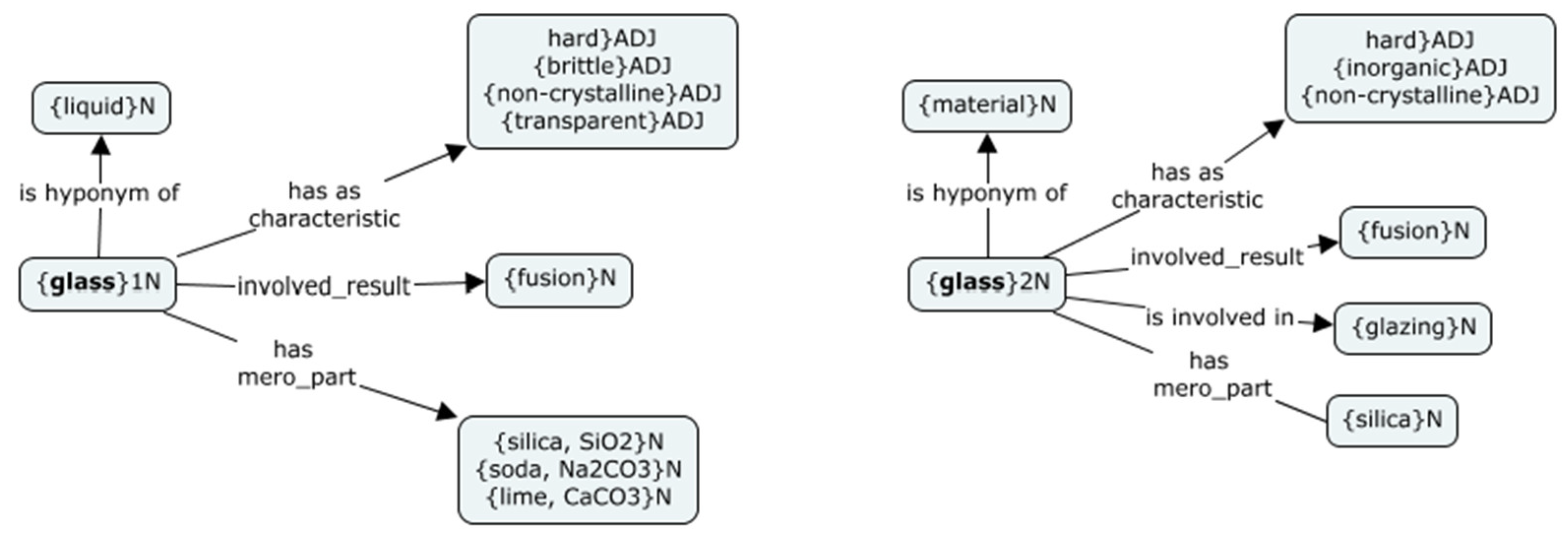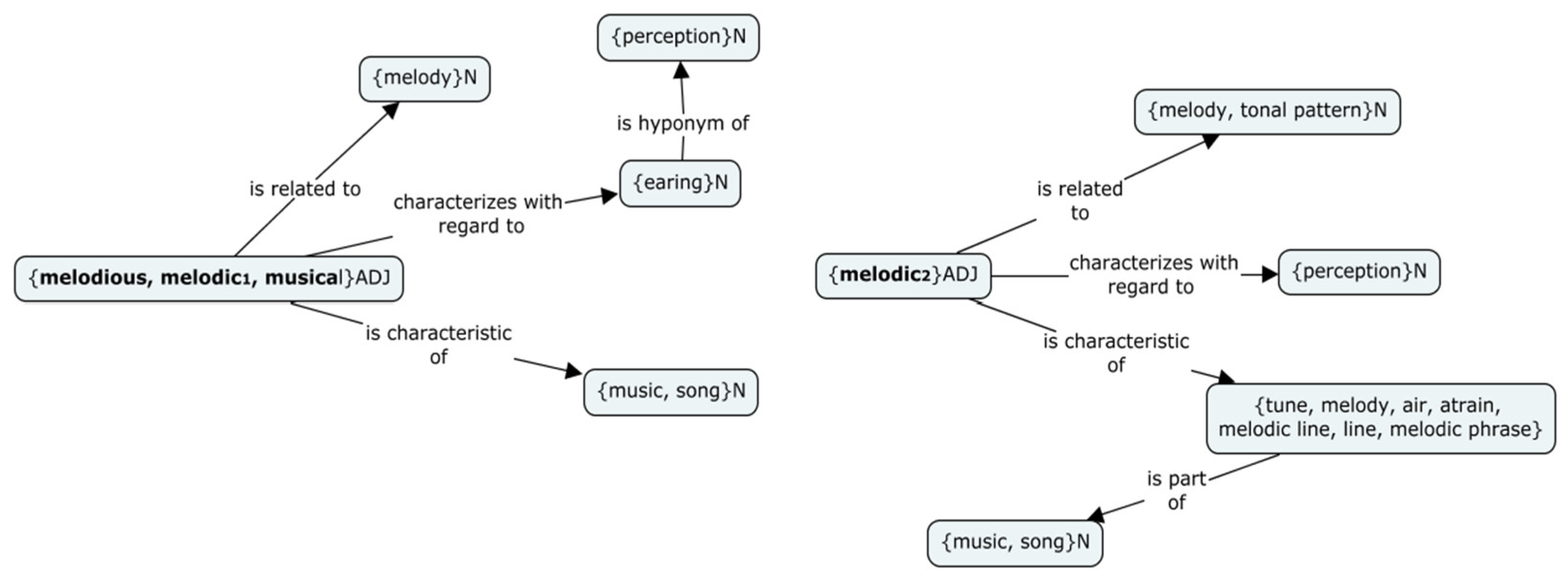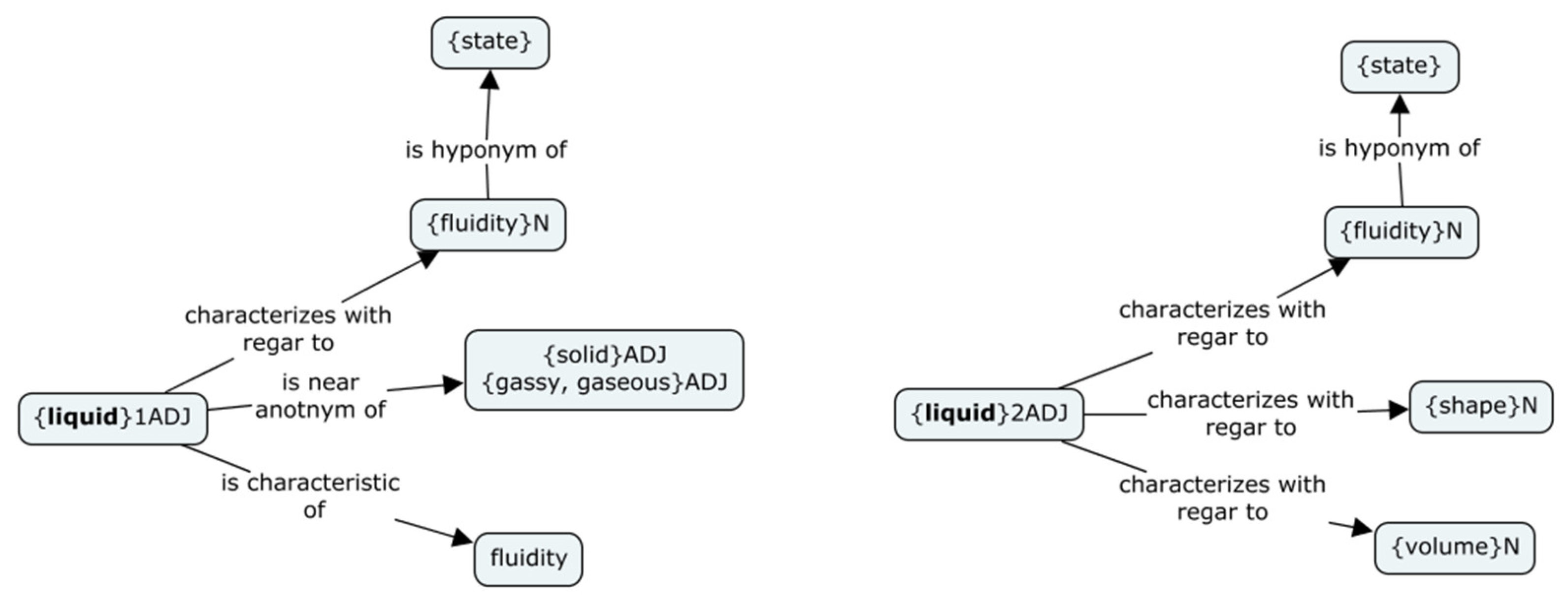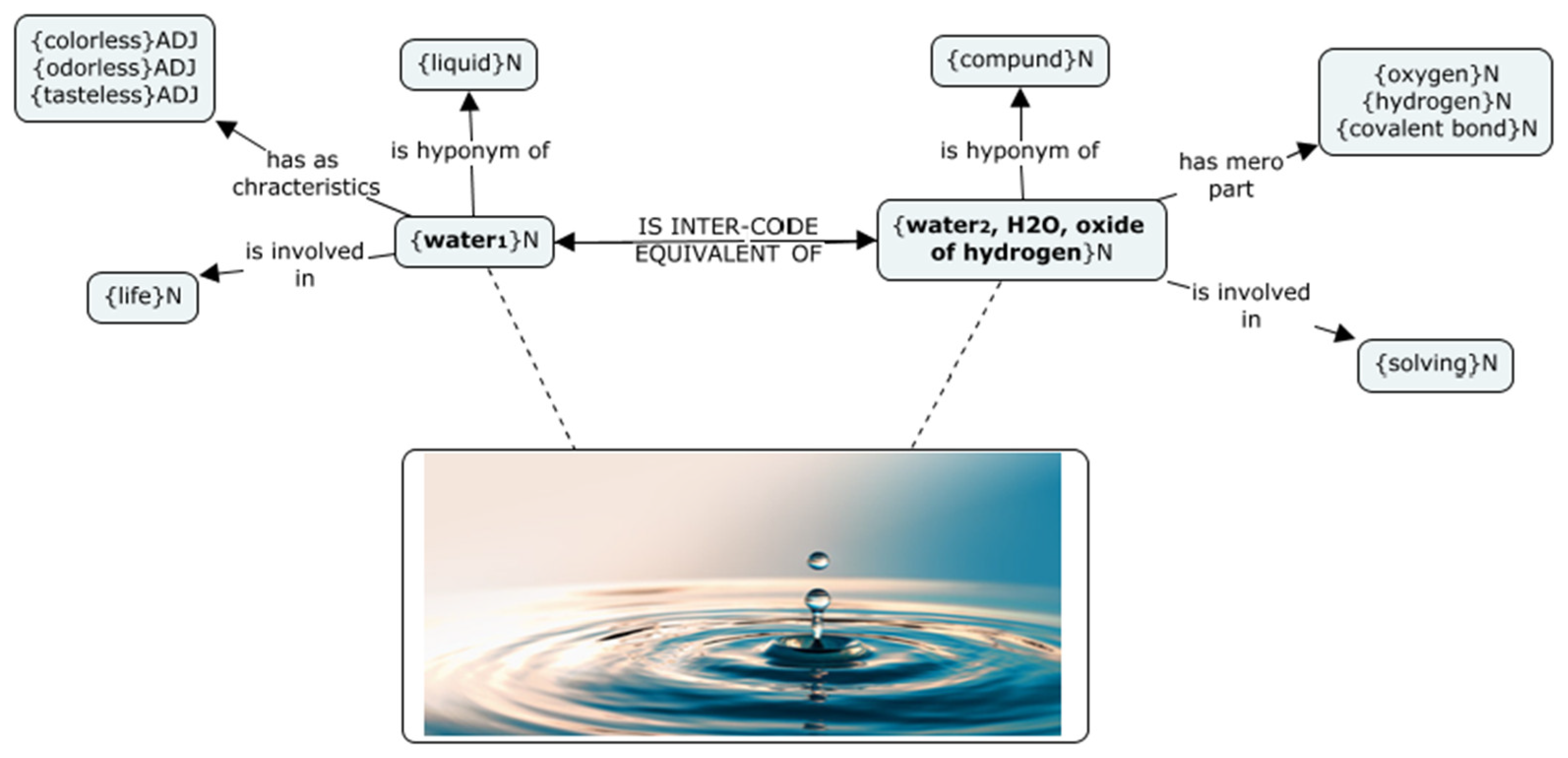Are We Talking about the Same Thing? Modeling Semantic Similarity between Common and Specialized Lexica in WordNet
Abstract
:1. Introduction
2. Methods and Framework
- -
- Word/lexical unit: linguistic unit that consists of a set of sounds/characters with morphological and syntactic properties with which a given stable meaning is associated.
- -
- Meaning: linguistic unit that consists of set of semantic properties/values stably associated to a given word, reflecting prototypical conceptual knowledge, typically including a hypernym and specific and differentiating characteristics.
- -
- Concept: knowledge unit that consists of a (mental) representation of a specific part of information, individualized by cognitive processes. Conceptual aspects concern, thus, the cognitive aspects relevant to the establishment and identification of a given portion of knowledge, and the conceptualization process concerns the cognitive process that defines the cognitive aspects and properties relevant to the delineation of a given concept.
- X is hyponym of Y ifX is a type of Y and Y is not a type of X.
- 2.
- a. He bought a pitbull, but the dog doesn’t bite.b. He crawled through the woods, moving so to avoid being seen by the guards.c. Marine animals can be endangered by the near proximity of cities since many aquatic animals are easily affected by sewage pollution (adapted from Amaro 2009, p. 26).
3. A New Relation for Integrating Common and Specialized Lexica
- -
- Reference potential: the ability of words to indicate specific parts/elements of the real world. Therefore, the referent isthe part/element of the real world that a given word indicates, when used in a defined context.
3.1. Inter-Code Equivalence
- -
- Compatible synsets: the specialized synset denotes a concept similar to the one denotated by the common node, but more precise. The hypernym chain is the same for both synsets, but the specialized synset establishes more horizontal relations.
- -
- Semi-compatible synsets: the specialized hypernym chain has an intermediary hypernym expressing some specification about the specialized concept that does not exist in the common lexicon network.
- -
- Incompatible synsets: the specialized and common nodes, though related, do not share elements in the hypernym chain, directly or indirectly. In that case, there is no possible merging.
- -
- Two intentional denotations partially overlapping (i.e., the two different sets of features that determine the meaning of the lexical unit, corresponding to the sets of lexical conceptual relations each node establishes with the other nodes in the network);
- -
- Two different sets of synonyms that can refer to the class of entities that satisfy the sense. In other words, two ways of mentioning the concept at stake, respectively: {attic, loft, garret} and {attic}.
- 3.
- INTER-CODE EQUIVALENCE: Relation established between two synsets from common and specialized lexica with the same part of speech (POS), that stands for a relevant degree of sharing of semantic and conceptual properties, reflected by the sharing of the hypernymy chain (directly or indirectly) and of other horizontal relations.
- 4.
- X IS INTER-CODE EQUIVALENT TO Y if
- 5.
- a. {attic1, loft, garret}N belongs to common lexicon and {attic2}N belongs to specialized lexicon—TRUE;
- 6.
- a. {virus}1N belongs to common lexicon and {{virus}2N belongs to specialized lexicon;
- 7.
- a. {glass}1N belongs to the specialized domain of chemistry and {glass}2N belongs to the specialized domain of materials engineering—TRUE;
Inter-Code Equivalence in Verbal and Adjectival Nodes
- Verbs.
- 8.
- a. ‘X demonstrates the problem for two hours’—‘The demonstration of the problem occurs 8 for two hours’ → A cyclic resultative verb supports an adverbial expression of duration—so does the deverbal nominalization.b. * ‘X solves the problem for two hours’—* ‘The solution of the problem occurs for two 11 h’ → A resultative verb does not support an adverbial expression of duration, and neither does the deverbal nominalization.
- -
- Directly, e.g., HYPERONYM relation and INVOLVES_INSTRUMENT relation;
- -
- Indirectly, e.g., INVOLVES_OBJECT relations.
- 9.
- {breathe1, take a breath, respire1, suspire}V IS INTER-CODE EQUIVALENT TO {breathe2, respire2}V ifa. {breathe1, take a breath, respire1, suspire}V belongs to common lexicon and {breathe2, respire2}V belongs to the specialized lexicon of the biology domain;
- Adjectives.
- 10.
- {melodious, melodic1, musical}ADJ IS INTER-CODE EQUIVALENT TO {melodic2}ADJ if
4. Discussion
- 11.
- {car, auto, automobile, machine, motorcar}N (≈motor vehicle with four wheels, usually propelled by an internal combustion engine).
- 12.
- a. {bank1}N (≈sloping land, especially the slope beside a body of water);
- 13.
- a. {spoon1}N (≈piece of cutlery with a shallow bowl-shaped container and a handle);
- 14.
- {hospital}N (≈medical institution where sick or injured people are given medical or surgical care);
- -
- different hypernyms: {liquid}N and {compound}N;
- -
- different horizontal relations, establishing different characteristics: {colorless}ADJ; {odorless}ADJ; {tasteless}ADJ; meronyms {oxygen}N; {hydrogen}N; {covalent bond}N; involvement relations expressing telicity {life}N and {solving}N, according to the salience and relevance of the conceptual information for the speaker or for the domain.
5. Conclusions
Author Contributions
Funding
Institutional Review Board Statement
Informed Consent Statement
Data Availability Statement
Acknowledgments
Conflicts of Interest
| 1 | Examples built based on the definitions and synsets presented in Amaro and Mendes (2012, p. 152), and in American Heritage® Dictionary of the English Language, Fifth Edition, 2016, and Collins English Dictionary—Complete and Unabridged, 12th Edition 2014 (https://www.thefreedictionary.com/attic), (accessed on 1 January 2023). |
| 2 | Synsets and glosses retrieved from WordNet 3.1 (https://wordnet.princeton.edu/), (accessed on 1 January 2023). |
| 3 | Synsets in examples (11) to (14) were adapted from WordNet 3.1 (https://wordnet.princeton.edu). We uniformized the glosses by using the formula direct hyperonym + specific differences. |
References
- Amaro, Raquel. 2009. Computation of Verbal Predicates in Portuguese: Relational Network, Lexical-Conceptual Structure and Context. Ph.D. thesis, University of Lisbon, Lisbon, Portugal. [Google Scholar]
- Amaro, Raquel, and Sara Mendes. 2012. Towards merging common and technical lexicon wordnets. In Proceedings of the 3rd Workshop on Cognitive Aspects of the Lexicon. Mumbai: The COLING 2012 Organizing Committee, pp. 147–60. Available online: https://aclanthology.org/W12-5100 (accessed on 1 December 2023).
- Amaro, Raquel, Sara Mendes, and Palmira Marrafa. 2013. Increasing Density through New Relations and PoS Encoding in WordNet.PT. International Journal of Computational Linguistics and Applications 4: 11–27. [Google Scholar]
- Anscombre, Jean-Claude. 1986. Article zéro, termes de masse et représentation d’événements en français contemporain. Recherches Linguistiques 11: 5–34. [Google Scholar]
- Baker, Collin. 2014. FrameNet: A Knowledge Base for Natural Language Processing. In Proceedings of 3 Frame Semantics in NLP: A Workshop in Honor of Chuck Fillmore (1929–2014). Baltimore: Association for Computational Linguistics, pp. 1–5. [Google Scholar] [CrossRef]
- Bentivogli, Luisa, Andrea Bocco, and Emanuele Pianta. 2004. ArchiWordNet: Integrating WordNet with Domain-Specific Knowledge. Paper presented at the 2nd International Global Wordnet Conference, Brno, Czech Republic, January 20–23; pp. 39–47. Available online: https://www.fi.muni.cz/gwc2004/ (accessed on 1 December 2023).
- Buitelaar, Paul. 1998. CoreLex: An Ontology of Systematic Polysemous Classes. In Proceedings of the 11 1st International Conference on Formal Ontology in Information Systems. Trento: IOS Press, vol. 46, pp. 221–35. Available online: http://www.coli.uni-saarland.de/publikationen/softcopies/Buitelaar:1998:COS.pdf (accessed on 1 December 2023).
- Cabré, Maria Teresa. 1999. Terminology: Theory, Methods and Applications. Amsterdam and Philadelphia: John Benjamins Publishing Company. [Google Scholar]
- Chen, Rung Ching, Cho Tscan Bau, and Chun Ju Yeh. 2011. Merging domain ontologies based on the WordNet system and Fuzzy Formal Concept Analysis techniques. Applied Soft Computing Journal 11: 1908–23. [Google Scholar] [CrossRef]
- Copestake, Ann. 1995. Representing lexical polysemy. Paper presented at the AAAI Spring Symposium on Representation and Acquisition of Lexical Knowledge Polysemy Ambiguity and Generativity, Palo Alto, CA, USA, March 27–29; pp. 21–22. Available online: https://www.aaai.org/Papers/Symposia/Spring/1995/SS-95-01/SS95-01-006.pdf (accessed on 1 December 2023).
- Copestake, Ann, and Ted Briscoe. 1995. Semi-productive polysemy and sense extension. Journal of Semantics 12: 15–67. [Google Scholar] [CrossRef]
- Correia, Clara Nunes. 2002. Estudos de determinação. A operação de quantificação-qualificação em sintagmas nominais. In Textos. Lisbon: Fundação Calouste Gulbenkian e Fundação para a Ciência e a Tecnologia. [Google Scholar]
- Cruse, Alan. 1986. Lexical Semantics. Cambridge, UK: Cambridge University Press. [Google Scholar]
- Cruse, Alan. 2000. Meaning in Language. An introduction to Semantics and Pragmatics, 2nd ed. Oxford: Oxford University Press. [Google Scholar]
- Elhadad, Noemie, and Komal Sutaria. 2007. Mining a Lexicon of Technical Terms and Lay Equivalents. In Proceedings of the Workshop on BioNLP 2007: Biological, Translational, and Clinical Language Processing. Prague: Association for Computational Linguistics Stroudsburg, pp. 49–56. [Google Scholar] [CrossRef]
- Fellbaum, Christiane, ed. 1998. Wordnet: An Electronical Database. Cambridge, UK: MIT Press. [Google Scholar]
- Freihat, Abed Alhakim, Fausto Giunchiglia, and Biswanath Dutta. 2013. Solving Specialization Polysemy in WordNet. International Journal of Computational Linguistics and Applications 4: 29–52. [Google Scholar]
- Fuentes, Alejandro Curado. 2001. Lexical behaviour in academic and technical corpora: Implications for ESP development. Language Learning & Technology 5: 106–29. [Google Scholar]
- Geeraerts, Dirk. 2010. Theories of Lexical Semantics. Oxford: Oxford University Press. [Google Scholar]
- Gotti, Maurizio. 2003. Investigating Specialized Discourse. Lausanne: Peter Lang. [Google Scholar]
- Guo, Yue, Joseph Chee Chang, Maria Antoniak, Erin Bransom, Trevor Cohen, Lucy Lu Wang, and Tal August. 2023. Personalized Jargon Identification for Enhanced Interdisciplinary Communication. arXiv arXiv:2311.09481. [Google Scholar] [CrossRef]
- Huth, Alexander, G. Wendy A. de Heer, Thomas L. Griffiths, Frédéric E. Theunissen, and Jack L. Gallant. 2016. Natural speech reveals the semantic maps that tile human cerebral cortex. Nature 532: 453–58. [Google Scholar] [CrossRef] [PubMed]
- Khoo, Christopher S. G., and Jin-Cheon Na. 2006. Semantic Relations in Information Science. Annual Review of Information Science and Technology 40: 157–228. [Google Scholar] [CrossRef]
- León Araúz, Pilar, Pamela Faber, and Silvia Montero Martínez. 2012. Specialized language semantics. In A Cognitive Linguistics View of Terminology and Specialized Language. Edited by Pamela Faber. Berlin and Boston: De Gruyter Mouton, pp. 133–211. [Google Scholar]
- L’Homme, Marie-Claude. 2002. What can Verbs and Adjectives Tell us about Terms? Paper presented at the Proceedings of Terminology and Knowledge Engineering. 6th International Conference, Nancy, France, August 28–30. [Google Scholar]
- L’Homme, Marie-Claude. 2007. Using Explanatory and Combinatorial Lexicology to Describe Terms. In Selected Lexical and Grammatical Issues in the Meaning-Text Theory. In Honour of Igor Mel’cuk. Amsterdam and Philadelphia: John Benjamins Publishing Company, pp. 13–50. [Google Scholar]
- Llach, Maria Pilar Agustín. 2023. Mapping the mental lexicon of EFL learners: A network approach. Revista de lingüística y lenguas aplicadas 18: 1–17. [Google Scholar] [CrossRef]
- Loukachevitch, Natalia, and Boris Dobrov. 2004. Sociopolitical Domain As a Bridge from General 17 Words to Terms of Specific Domains. Paper presented at Second Global Wordnet Conference, Brno, Czech Republic, January 20–23; pp. 163–68. Available online: https://www.fi.muni.cz/gwc2004/ (accessed on 1 December 2023).
- López Rodríguez, Clara Inés. 2007. Understanding scientific communication through the extraction of the conceptual and rhetorical information codified by verbs. Terminology. International Journal of Theoretical and Applied Issues in Specialized Communication 13: 61–84. [Google Scholar] [CrossRef]
- Magnini, Bernardo, and Manuela Speranza. 2001. Integrating Generic and Specialized Wordnets. Paper presented at the Proceedings of Recent Advances in Natural Language Processing, RANLP-2001, Tzigov Chark, Bulgaria, September 5–7; pp. 149–53. [Google Scholar]
- Mendes, Sara. 2009. Syntax and Semantics of Adjectives in Portuguese Analysis and Modelling. Ph.D. thesis, University of Lisbon, Lisbon, Portugal. [Google Scholar]
- Mendes, Sara, and Rui Pedro Chaves. 2001. Enriching WordNet with qualia information. In Proceedings of NAACL 2001 Workshop on WordNet and Other Lexical Resources. Available online: http://citeseerx.ist.psu.edu/viewdoc/download;jsessionid=C77AC228C66D794A11FAAEC574329B3E49?doi=10.1.1.20.7438&rep=rep1&type=pdf (accessed on 1 December 2023).
- Miller, George, Richard Beckwith, Christiane Fellbaum, Derek Gross, and Katherine Miller. 1990. Introduction to WordNet: An on-line lexical database. International Journal of Lexicography 3: 235–44. [Google Scholar] [CrossRef]
- Motos, Raquel Martínez. 2011. The Role of Interdisciplinarity in Lexicography and Lexicology. In New Approaches to Specialized English Lexicology and Lexicography. Newcastle upon Tyne: Cambridge Scholars Publishing, pp. 3–15. [Google Scholar]
- Pearson, Jennifer. 1998. Terms in Context. Amsterdam: John Benjamins Publishing Company. [Google Scholar]
- Pedersen, Ted, Serguei Pakhomov, Bridget McInnes, and Ying Liu. 2012. Measuring the similarity and relatedness of concepts in the medical domain. Paper presented at the 2nd ACM SIGHIT International Health Informatics Symposium, Miami, FL, USA, January 28–30; New York: ACM, pp. 879–80. [Google Scholar] [CrossRef]
- Pustejovsky, James. 1995. The Generative Lexicon. Massachusetts: MIT Press. [Google Scholar]
- Qiu, Mengyang, Nichol Castro, and Brendan Johns. 2021. Structural Comparisons of Noun and Verb Networks in the Mental Lexicon. Proceedings of the Annual Meeting of the Cognitive Science Society 43: 1649–55. Available online: https://escholarship.org/uc/item/4b20s6wp (accessed on 1 December 2023).
- Roventini, Adriana, and Rita Marinelli. 2004. Extending the Italian WordNet with the Specialized Language of the Maritime Domain. Paper presented at the 2nd International Global Wordnet Conference, Brno, Czech Republic, January 20–23; pp. 193–98. Available online: https://www.fi.muni.cz/gwc2004/ (accessed on 1 December 2023).
- Roventini, Adriana, Antonietta Alonge, Nicoletta Calzolari, Bernardo Magnini, and Francesca Bertagna. 2000. ItalWordNet: A Large Semantic Database for Italian. Paper presented at the 2nd International Conference on Language Resources and Evaluation, Athens, Greece, May 31–June 2; pp. 783–90. Available online: http://www.lrec-50conf.org/proceedings/lrec2000/pdf/129.pdf (accessed on 1 December 2023).
- Sagri, Maria Teresa, Daniela Tiscornia, and Francesca Bertagna. 2004. Jur-WordNet. Paper presented at the 2nd International Global Wordnet Conference, Brno, Czech Republic, January 20–23; pp. 305–10. Available online: https://www.fi.muni.cz/gwc2004/ (accessed on 1 December 2023).
- Siew, Cynthia. 2022. Investigating Cognitive Network Models of Learners’ Knowledge Representation. Journal of Learning Analytics 9: 120–29. [Google Scholar] [CrossRef]
- Siew, Cynthia S. Q., and Anuta Guru. 2023. Investigating the network structure of domain-specific knowledge using the semantic fluency task. Memory & Cognition 51: 623–46. [Google Scholar] [CrossRef]
- Smith, Barry, and Christiane Fellbaum. 2004. Medical WordNet: A New Methodology for the Construction and Validation of Information Resources for Consumer Health. Paper presented at the COLING—The 20th International Conference on Computational Linguistics, Geneva, Switzerland, August 23–27; Geneva: Association for Computational Linguistics, pp. 371–83. Available online: https://dl.acm.org/citation.cfm?id=1220409 (accessed on 1 December 2023).
- Vendler, Zeno. 1967. Linguistics in Philosophy. Ithaca: Cornell University Press. [Google Scholar]
- Vossen, Piek. 2002. EuroWordNet General Document. Amsterdam: University of Amsterdam. Available online: https://research.vu.nl/ws/portalfiles/portal/77020259/EWNGeneral (accessed on 1 December 2023).
- Vossen, Piek, Marten Postma, and Filip Ilievski. 2018. ReferenceNet: A semantic-pragmatic network for capturing reference relations. Paper presented at the 9th Global Wordnet Conference, Singapore, January 8–12; pp. 219–28. Available online: http://compling.hss.ntu.edu.sg/events/2018-gwc/pdfs/gwc-2018-proceedings.pdf (accessed on 1 December 2023).
- Winowiecki, Leigh, Sean Smukler, Kenneth Shirley, Roseline Remans, Gretchen Peltier, Erin Lothes, Elisabeth King, Liza Comita, Sandra Baptista, and Leontine Alkema. 2011. Tools for enhancing interdisciplinary communication. Sustainability: Science, Practice and Policy 7: 74–80. [Google Scholar] [CrossRef]
- Wulff, Dirk U., Simon De Deyne, Michael N. Jones, Rui Mata, and The Aging Lexicon Consortium. 2019. New perspectives on the aging lexicon. Trends in Cognitive Sciences 23: 686–98. [Google Scholar] [CrossRef] [PubMed]
- Yee, Eiling, Michael N. Jones, and Ken McRae. 2018. Semantic memory. In The Stevens’ Handbook of Experimental Psychology and Cognitive Neuroscience. New York: Wiley, vol. 3. [Google Scholar] [CrossRef]













Disclaimer/Publisher’s Note: The statements, opinions and data contained in all publications are solely those of the individual author(s) and contributor(s) and not of MDPI and/or the editor(s). MDPI and/or the editor(s) disclaim responsibility for any injury to people or property resulting from any ideas, methods, instructions or products referred to in the content. |
© 2024 by the authors. Licensee MDPI, Basel, Switzerland. This article is an open access article distributed under the terms and conditions of the Creative Commons Attribution (CC BY) license (https://creativecommons.org/licenses/by/4.0/).
Share and Cite
Barbero, C.; Amaro, R. Are We Talking about the Same Thing? Modeling Semantic Similarity between Common and Specialized Lexica in WordNet. Languages 2024, 9, 89. https://doi.org/10.3390/languages9030089
Barbero C, Amaro R. Are We Talking about the Same Thing? Modeling Semantic Similarity between Common and Specialized Lexica in WordNet. Languages. 2024; 9(3):89. https://doi.org/10.3390/languages9030089
Chicago/Turabian StyleBarbero, Chiara, and Raquel Amaro. 2024. "Are We Talking about the Same Thing? Modeling Semantic Similarity between Common and Specialized Lexica in WordNet" Languages 9, no. 3: 89. https://doi.org/10.3390/languages9030089






